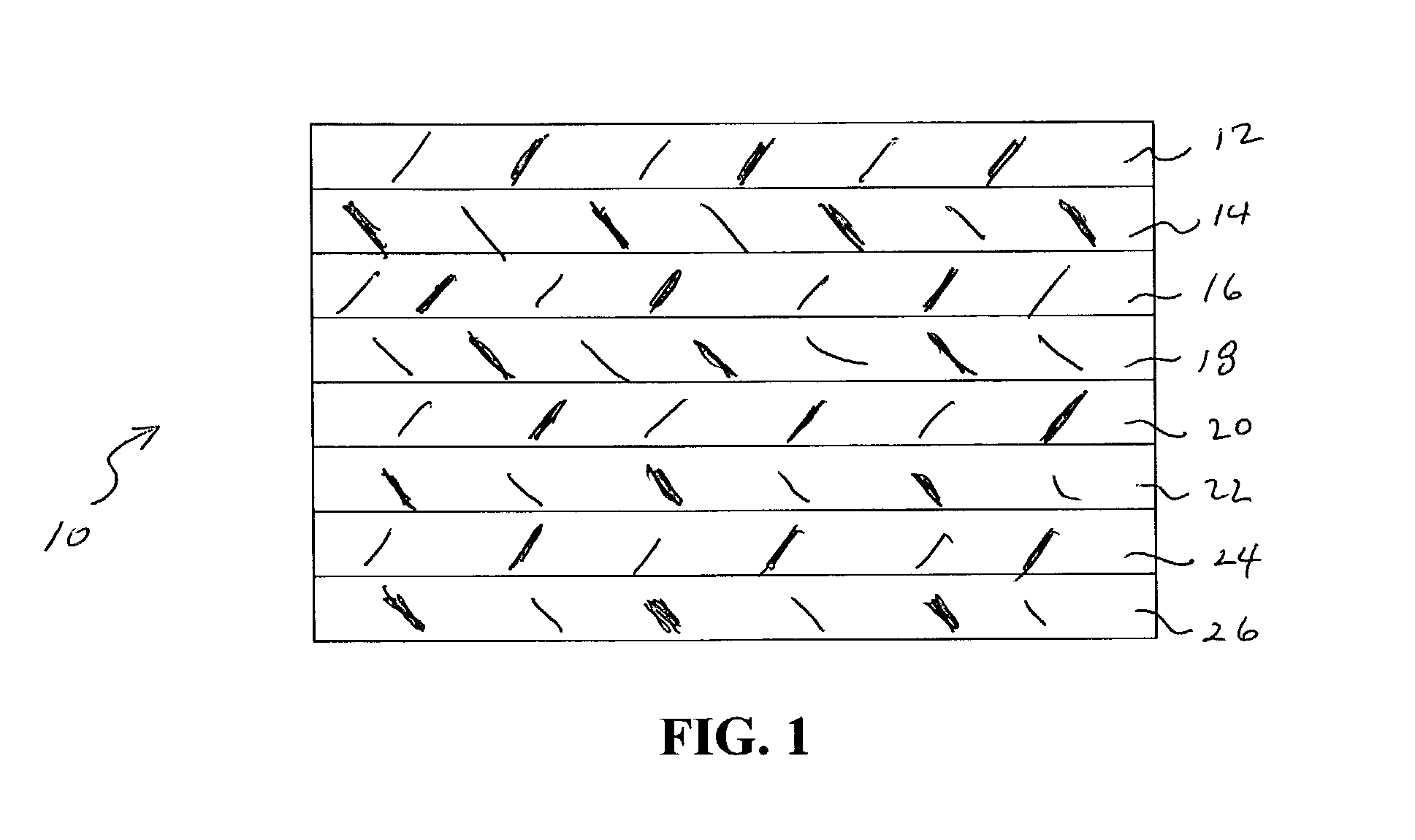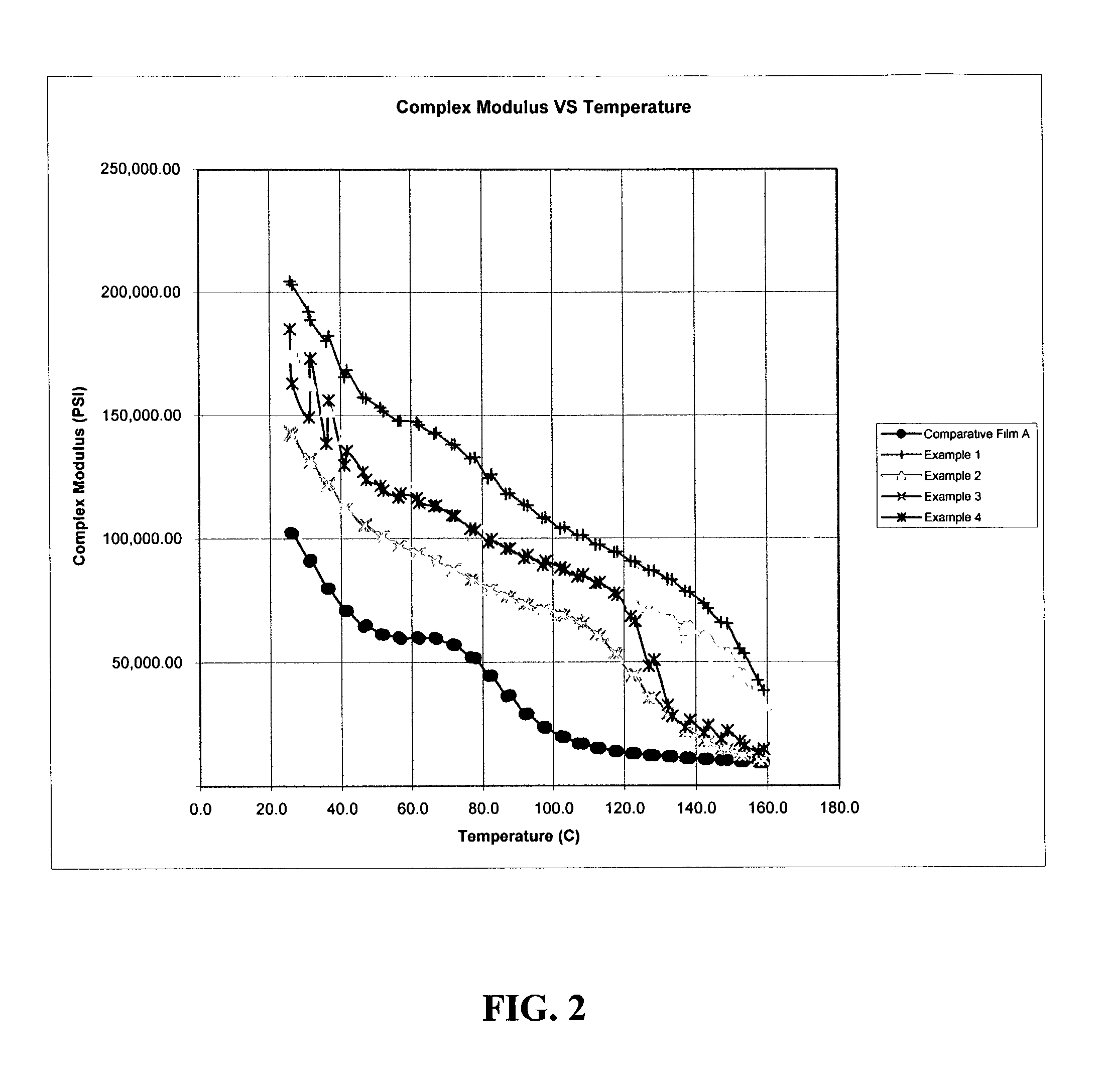High modulus, temperature-resistant film for form fill and seal packaging
a temperature-resistant film, high modulus technology, applied in the field of films, to achieve the effect of high heat resistance, low curl and high stiffness
- Summary
- Abstract
- Description
- Claims
- Application Information
AI Technical Summary
Benefits of technology
Problems solved by technology
Method used
Image
Examples
example 1
[0062]With reference to FIG. 1, a multilayer film in accordance with the present invention had the following eight-layer structure (total film thickness ranging from 2.2–2.48 mils):
[0063]
Layer 1:94% EVA-1 + 6% MB3 (20.3% of total thickness of layers 1–8).Layer 2:60% COC3 + 40% HEAO-1 (37.2% of total thickness oflayers 1–8).Layer 3:TIE-4 (6.3% of total thickness of layers 1–8).Layer 4:PA6-1 (6.8% of total thickness of layers 1–8).Layer 5:EVOH-3 (9.6% of total thickness of layers 1–8).Layer 6:PA6-1 (4.9% of total thickness of layers 1–8).Layer 7:Tie-4 (6.3% of total thickness of layers 1–8).Layer 8:96% a-PA-2 + 2% MB-1 + 2% MB-4 (8.6% of total thicknessof layers 1–8).
The film was fully coextruded and produced by a cast coextrusion process using a slot die, followed by a water quench upon exiting the die.
example 2
[0064]Again with reference to FIG. 1, multilayer films in accordance with the present invention were made as described in Example 1, each having the following eight-layer structure, with total film thicknesses ranging from 1.9 to 3.6 mils. Various film thicknesses were produced in order to identify the preferred total thickness based on field test results.
[0065]
Layer 1:94% EVA-1 + 6% MB3 (18.8% of total thickness of layers 1–8).Layer 2:60% COC3 + 40% HEAO-1 (39.3% of total thickness oflayers 1–8).Layer 3:TIE-4 (5.8% of total thickness of layers 1–8).Layer 4:PA6-1 (6.4% of total thickness of layers 1–8).Layer 5:EVOH-3 (9.3% of total thickness of layers 1–8).Layer 6:PA6-1 (6.8% of total thickness of layers 1–8).Layer 7:Tie-4 (6.8% of total thickness of layers 1–8).Layer 8:96% PA6-2 + 2% MB-1 + 2% MB-4 (6.8% of total thickness oflayers 1–8).
example 3
[0066]Again with reference to FIG. 1, a multilayer film in accordance with the present invention was made as described in Example 1 and had the following eight-layer structure (total film thickness ranging from 2.2–2.48 mils):
[0067]
Layer 1:94% HEAO-2 + 6% MB3 (19.3% of total thickness of layers1–8).Layer 2:HEAO-2 (18.0% of total thickness of layers 1–8).Layer 3:50% COC-3 + 50% HEAO-1 (24.4% of total thicknessof layers 1–8).Layer 4:TIE-4 (4.4% of total thickness of layers 1–8).Layer 5:EVOH-3 (8.3% of total thickness of layers 1–8).Layer 6:Tie-4 (3.4% of total thickness of layers 1–8).Layer 7:Tie-4 (10.1% of total thickness of layers 1–8).Layer 8:96% a-PA-1 + 2% MB-1 + 2% MB-4 (12.1% of total thicknessof layers 1–8).
PUM
| Property | Measurement | Unit |
|---|---|---|
| glass transition temperature | aaaaa | aaaaa |
| temperature | aaaaa | aaaaa |
| elongation at break | aaaaa | aaaaa |
Abstract
Description
Claims
Application Information
 Login to View More
Login to View More - R&D
- Intellectual Property
- Life Sciences
- Materials
- Tech Scout
- Unparalleled Data Quality
- Higher Quality Content
- 60% Fewer Hallucinations
Browse by: Latest US Patents, China's latest patents, Technical Efficacy Thesaurus, Application Domain, Technology Topic, Popular Technical Reports.
© 2025 PatSnap. All rights reserved.Legal|Privacy policy|Modern Slavery Act Transparency Statement|Sitemap|About US| Contact US: help@patsnap.com


